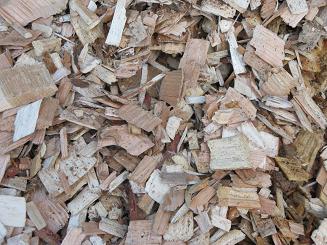By S. Ashton
Dry-matter loss, which is the degradation of lignin, cellulose, and hemicellulose, occurs when wet woody biomass, in any form, is not utilized immediately. The degree to which dry-matter loss occurs, is largely dependent on the materials moisture content. Woody biomass having higher moisture content is more susceptible to colonization by fungi and mold and at a faster rate (Richardson et al, 2002). These microorganisms, via metabolic activity, generate heat which in turn accelerates oxidation, moisture adsorption, hydrolysis, pyrolysis, and other chemical processes resulting in dry-matter loss. Dry-matter loss results in a reduction of overall energy content as well as leads to an increase in ash content (Richardson et al, 2002).
Several studies (Thornqvist and Jirjis 1990; Fredholm and Jirjis 1998) have observed dry matter loss in stored woody biomass. Green chips stored in a large pile for seven months lost approximately 12 percent of their dry matter and bark stored in a large pile for six months lost approximately 26% of their dry matter. The dry-matter loss in the bark pile resulted in a 20 percent decrease in energy content.
Dry-matter loss is particularly a problem in chipped material. This is because 1) chipping increases the area of exposed surfaces on which microbial activity can occur, 2) the small particle size gained by chipping restricts air flow and prevents heat dissipation, and 3) chipping releases the soluble contents of plant cells providing microbes with nutrients (Richardson et al, 2002). Increases in ash content due to dry-matter loss are also higher with chipped material; although, the reasons for this remain unclear (Richardson et al, 2002).
References
- Fredholm R, Jirjis R. 1988. Seasonal storage of bark from wet stored logs. Report No. 200. Uppsala, Sweden: Swedish University of Agricultural Sciences. 31 p.
- Richardson J, Bjorheden R, Hakkila P, Lowe AT, Smith CT. 2002. Bioenergy from sustainable forestry: guiding principles and practice. Dordrecht, The Netherlands: Kluwer Academic Publishers. 344 p.
- Thornqvist T, Jirjis R. 1990. Changes in fuel chips during storage in large piles. Reort No. 219. Uppsala, Sweden: Swedish University of Agricultural Scineces, Department of Forest Products.
- Used with permission from Hubbard, W., L. Biles, C. Mayfield and S. Ashton. (eds.) 2007. Sustainable forestry for bioenergy and biobased products: Trainers curriculum notebook. Athens, GA: Southern Forest Research Partnership, Inc.
